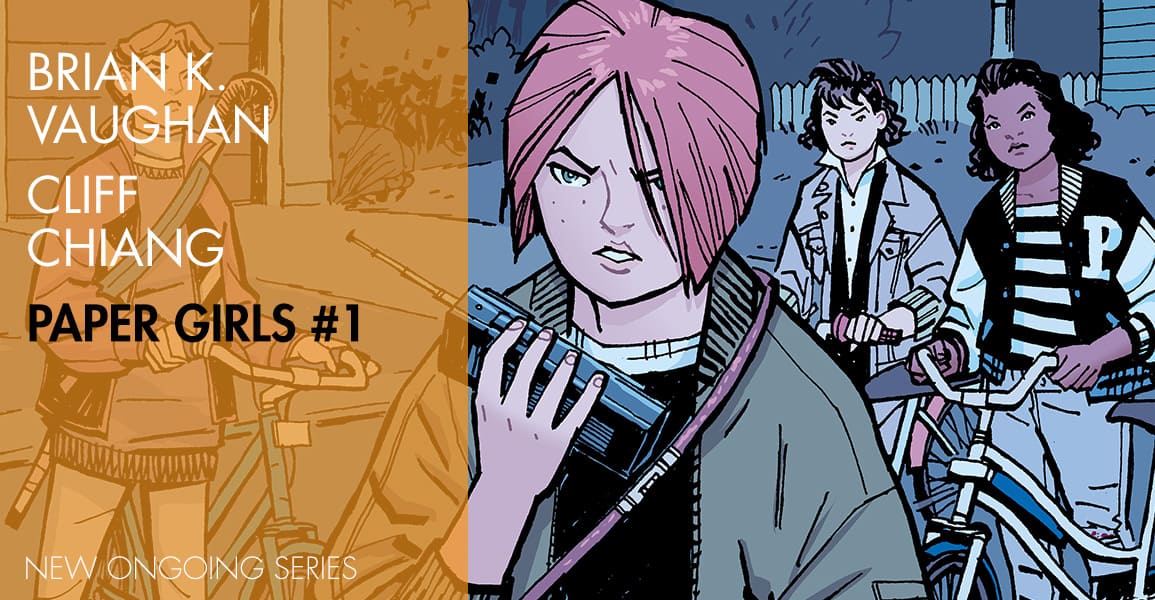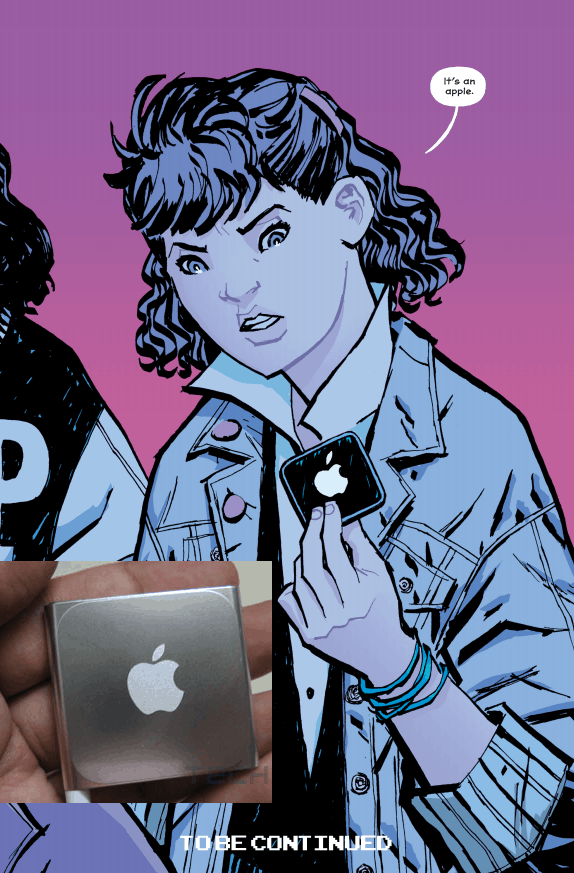Written by Brian K. Vaughan
Art and Cover by Cliff Chiang
Colors by Matt Wilson
Letters and Design by Jared K. Fletcher
Published by Image Comics on October 7, 2015
I am Erin (see byline and comparison photo). I was a preteen in 1988, sporting the same hair and stone washed jean jacket (though mine was pink). I was tough (especially in defending my friends) and responsible and Catholic. I had that pastel Sharp boombox, the jelly bracelets, the four-color pen, the love of The Far Side. I had Tiffany’s Reebok high-tops and KJ’s stirrup pants, turtle neck, and overlarge sweatshirt combo outfit. I had many pairs of those slouch socks. So the setting of Paper Girls is uncannily familiar. The juxtaposition of elements of my childhood stored deep in my memory and the creepy, sci-fi unknown has awakened an immediate, obsessive engagement in me.
Nov. 1, 1988. “Hell morning” for four 12-year-old paper girls. Teaming up to minimize the abuse they might take from lingering drunk partiers, Erin, Mac, Tiffany, and KJ run into a completely unexpected adversary, and they’re clearly not locals. Image marketing calls it Stand by Me meets War of the Worlds. Vaughan brings his characteristic mix of the mundanely familiar and the fantastical to the storytelling, while Chiang amplifies the realism through his attention to detail, and Wilson color contrasts early morning blues with neon pink and yellow to evoke the late 80’s era and highlight emotional peaks. And in short, the collaboration is a-MAZE-ing.
Paper Girls opens in Erin’s early morning dreaming, the contemplation of an apple in her hands. The dream then incorporates her interest in the space program with her anxieties about nuclear annihilation, sin, school, and her responsibility to protect her sister. The appearance of Christa McAuliffe, the teacher who died in the Challenger explosion in 1986, visually calls to mind SAGA. The dream ends up being a crucial introduction to the story. While the next few pages will seem incredibly mundane, Erin and company will find evidence for an incredibly fantastical event happening in their neighborhood. The dream introduces the idea of fall from innocence with the apple and the reprimand to not eat from the tree of knowledge and that enables a wham-bam closure with the Apple device the mutant drops. It forshadows the strange and wonderous coming-of-age these girls face.
Vaughan writes the characters with authenticity and clarity. The four girls are easily distinguishable personalities. Each has distinct interests, concerns, and characteristics defined by dress, dialogue, and their response to the challenges thrown at them–MacKenzie’s the rebel, KJ’s the prep, Tiffany’s the AV nerd. Their relationships to each other are complex from the outset. Although new girl Erin has just met old pro MacKenzie, she both calls her out for using the term “faggot” (the other f-word) to taunt a troublesome teenager but also lies to a police officer to give her an alibi. Their dialogue is also peppered with slang of the era. Tiffany dismisses Mac’s homophobic slurs with the explanation that she just knows how to talk to those “herbs,” an insult out of the Esoteric slangbook meaning “lamer” or “punk.”
The dialogue pairs with Chiang’s attention to set dressing and Wilson’s use of color to make Paper Girls feel authentically like 1988 rather than a rough simulacra of the 80’s. I could keep listing the objects I recognize, but the point is that they’re recognizable. Chiang provides a casual realism with lines that remind me of poster markers in their thickness and angled ends.  Wilson uses cool blues for the early morning delivery hours and warm yellows for the light of kitchens and lit garage interiors. However, when something surprises the girls, Chiang and Wilson give us an emotion-forefronted close-up and eliminate the background, replacing the natural color choices of skin and sky with vivid, contrasting colors–teal and hot pink or yellow and burgundy. The choices give a punch of emotion and shock but also harken to the popular design colors of 1988.
Wilson uses cool blues for the early morning delivery hours and warm yellows for the light of kitchens and lit garage interiors. However, when something surprises the girls, Chiang and Wilson give us an emotion-forefronted close-up and eliminate the background, replacing the natural color choices of skin and sky with vivid, contrasting colors–teal and hot pink or yellow and burgundy. The choices give a punch of emotion and shock but also harken to the popular design colors of 1988.
The mystery as it unfolds offers some fantastic genre hooks providing possible insights into exactly what kind of strangeness sits in that basement and steals Tiffany’s two-way radio. First we see Erin’s Monster Squad poster, a film wherein preteen horror movie fans fight a real-life Dracula, Frankenstein, and Wolfman. The next horror reference comes in the form of a teenaged boy in a Freddy Kruger costume. He antagonises Erin until Mac, Tiffany, and KJ come to her rescue. Notably, this paper delivery “Hell morning” begins with a nightmare and takes place on many tree-named streets (Spruce, Poplar) but never Elm. Initially, our hooded mystery trio present a mummy-like menace with their lumbering stance, loose wraps, and inhuman eyes. However, the biologically-spliced NASA capsule calls to mind the sci-fi-oriented horror of Cronenberg’s The Fly. Turns out the mysterious trio also look a lot like Goldblum’s Seth Brundle with cyborg tech built onto their misshapen skulls.
Who are these guys?
KJ directly references the classic sci-fi legend of The War of the Worlds, desperately clinging to the possibility this might all be part of a hoax. But when a radiation blast from the capsule empowers the girls to see into deep space cosmos, KJ’s theory is dismissed. Is this an alien vessel? It seems to have come from space; but the attackers’ full face reveal make them look like grotesquely mutated humans, not aliens. Still, a satellite of some sort falls to Earth as Erin starts out on her deliveries, and I’m pretty sure its the capsule. And they don’t speak any form of Earthly language.
The final page of the issue introduces a new possibility–these mutated humans are time travelers. In their rush to escape the attacks of the girls, one of them drops an item the girls have never seen before. Erin identifies the Apple icon. This anachronism had to have come from the future. Other hints that indicate time travel: Erin’s Depeche Mode poster from the Music for the Masses Tour. One of the closing songs on the tour’s playlist is “A Question of Time.” Also, the comic’s tone, supernatural puzzle, and focus on teens matches that of Donnie Darko, a time travel story also set on and around Halloween, 1988. Finally, consultation with a Genius Bar expert identifies the Apple device as a 6th generation Nano, introduced in 2010, and one of the first smart watches. Perhaps 2010 is their starting spot, or maybe it was one of the places they stopped on their travels. I venture to guess that Tiffany’s two-way radio’s crystals are crucial to further modifying their vessel, perhaps to get themselves out of 1988 or to fix the radiation problem. Maybe the capsule is an escape pod from a larger biological ship like Farscape’s Moya.
Kudos to Brian K. Vaughan, Cliff Chiang, and Matt Wilson for creating one of the best first issues of a series I’ve read. I’m engaged with all aspects: characters, story, and art, and I’m anxiously anticipating further reveals of both the girls’ lives and personalities and the strange science fiction elements. This is just the tip of the Cronenbergian Tardis in the unfinished basement; it’s much bigger on the inside.
Rating: 10/10








